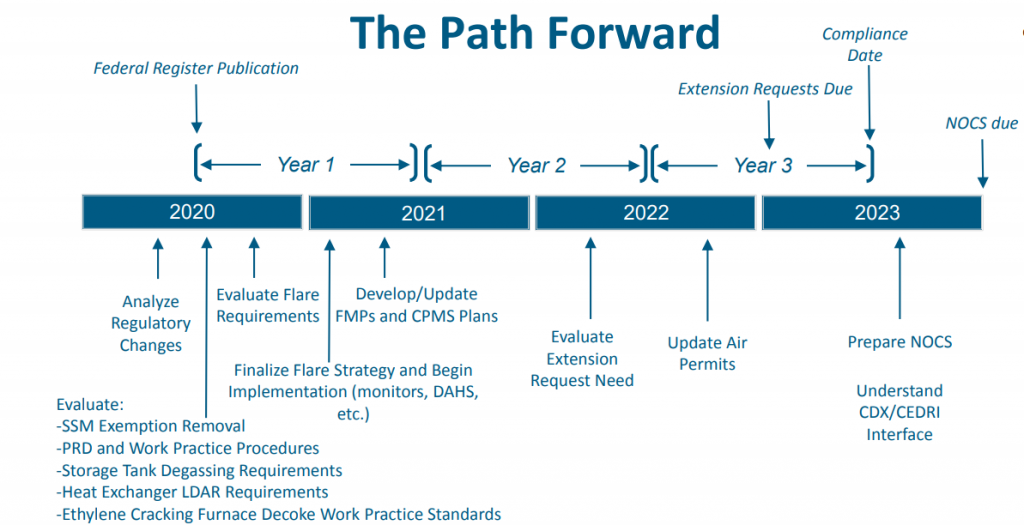My Facility is Subject to the EMACT – What Should I be doing Now?
Posted: July 20th, 2021
Authors: Meghan S.
The U.S. Environmental Protection Agency (U.S. EPA) finalized amendments to the National Emission Standards for Hazardous Air Pollutants (NESHAP): Generic Maximum Achievable Control Technology Standards for Ethylene Production, otherwise known as “EMACT” on July 6, 2020. Is your facility on the right path to complying with the new requirements?
WHAT CHANGED?
Major regulatory changes include the following:
- Changes to address treatment of startup, shutdown, and malfunction (SSM) events consistent with the 2008 vacatur of the SSM exemptions in 40 CFR Part 63 General Provisions.
- Work practices for decoking
- Revised flare monitoring requirements to ensure flares meet the EMACT standards at all times.
- Changes to leak monitoring methodology for heat exchangers.
- Additional restrictions on maintenance vents, bypasses, pressure relief devices, and in-situ sampling systems.
- Existing facilities must comply with the changes starting 3 years after publication of the final rule in the Federal Register (July 6, 2023).
- New facilities (facilities that commenced construction or reconstruction after October 9, 2019) must comply with the changes upon initial startup or July 6, 2020, whichever is later.
WHAT SHOULD MY FACILITY BE DOING NOW?
ALL4 recommends the following:
- Read the final rule, preamble, and U.S. EPA’s response to comment document and understand the impacts on your business and facilities. Evaluate the following:
-
- Changes to the definition of an “ethylene process vent,” which will cover maintenance vents in-situ sampling systems and the changes to using fuel gas
- SSM Exemption Removal
- PRD and Work Practice Procedures
- Storage Tank Degassing Requirements
- Heat Exchanger LDAR Requirements
- Ethylene Cracking Furnace Decoke Work Practice Standards
- Identify what additional internal and external resources you need to implement the rule.
- Develop your EMACT compliance approach.
- Identify any capital projects that will be required for compliance.
-
- Develop a timeline and schedule highlighting milestones.
- Can you accommodate these projects into an already planned outage such that the compliance deadline can be met?
- Identify what air permitting, if any, will need to be completed to support possible capital projects.
- Determine what additional information must be monitored and recorded to comply with the revised monitoring, recordkeeping, and reporting requirements.
-
- For example, depending on a facility’s current configuration, the flare monitoring requirements in 40 CFR Part 63, Subpart CC may require the installation of a gas chromatograph, a hydrogen analyzer, or a calorimeter.
- New flare gas, air, fuel, or steam monitoring and control equipment may also be required.
- Facilities should also consider any necessary upgrades to their data acquisition systems.
- Monitoring that may be required for temporary flares, in addition to temporary control devices used to control storage tank degassing emissions.
- Determine what internal procedures and plans need to be updated as a result of the rule changes.
-
- Flare Management Plans
- Continuous Parametric Monitoring Plans
- Site Standard Operating Procedures (SOPs) to conduct and document root cause analysis for PRDs and flares.
ALL4 has a variety of chemical sector experience, including ethylene. We are well versed in the Refinery RTR flare requirements and can assist EMACT facilities with the new flare requirements including developing monitoring plans, identifying required monitoring systems, and/or preparing procurement specifications for equipment suppliers. We can also help facilities analyze, plan for, and comply with the new requirements for heat exchange systems, PRDs, and other emissions sources. Contact Meghan Skemp at mskemp@all4inc.com or 281.937.7553 ext 307.


